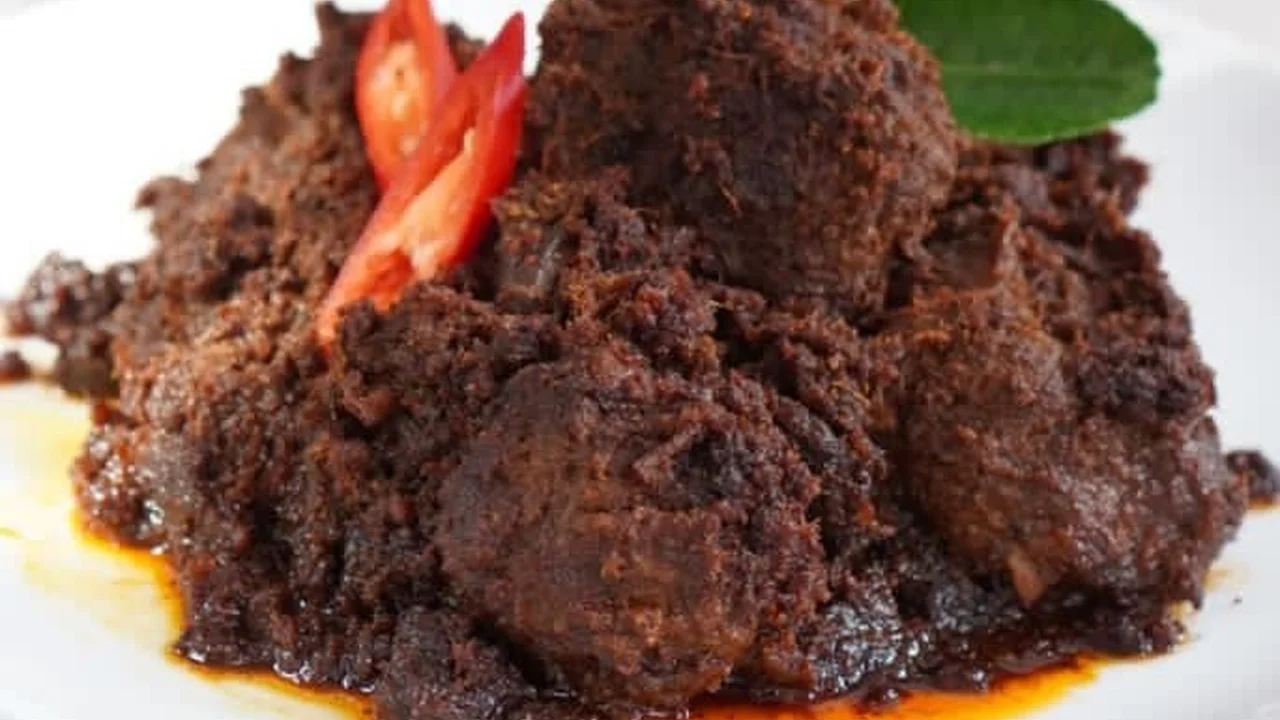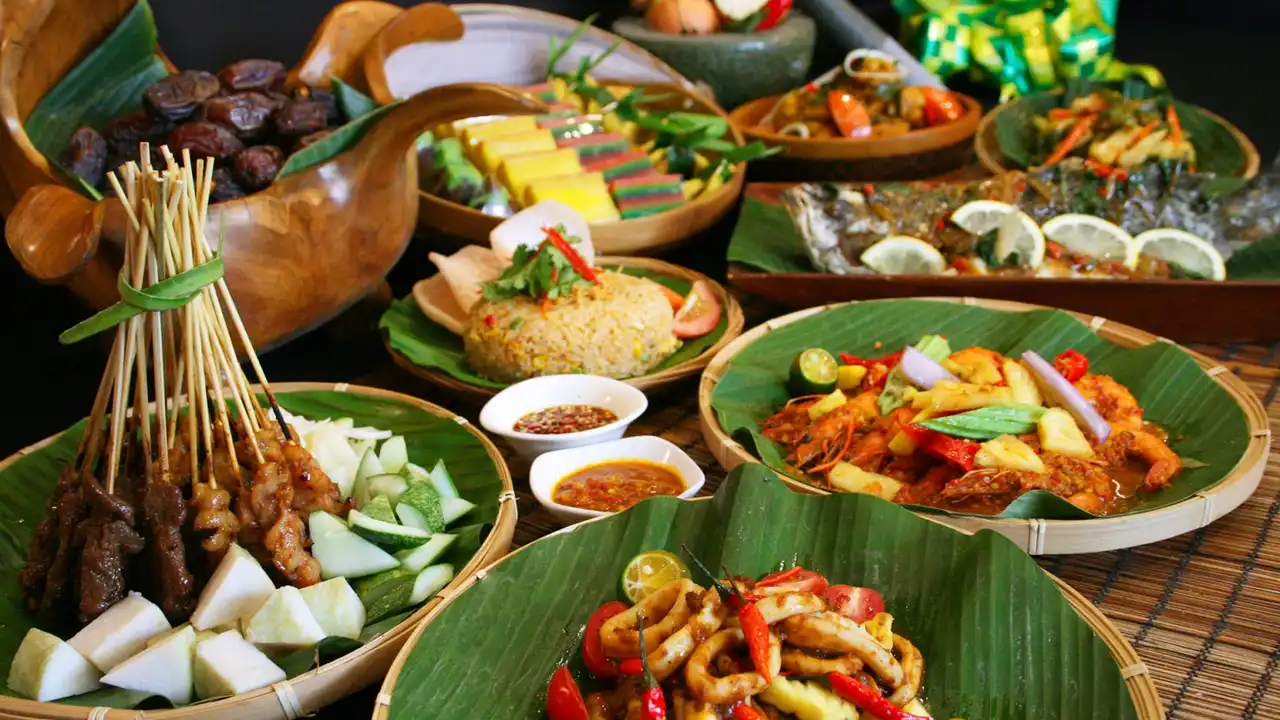Indonesian Rendang: A Culinary Masterpiece

Discovering the Rich History and Origins of Rendang An Indonesian Food Heritage
Rendang, often hailed as the king of Indonesian cuisine, is more than just a dish; it's a cultural icon. Originating from the Minangkabau region of West Sumatra, Indonesia, Rendang boasts a history as rich and complex as its flavor profile. This slow-cooked meat dish, simmered in coconut milk and an intricate blend of spices, has been a staple in Minangkabau society for centuries, traditionally served during ceremonial occasions and festive events. Its preparation is a testament to patience and dedication, requiring hours of slow simmering to achieve its signature tender texture and intensely flavorful sauce.
The name "Rendang" itself is believed to be derived from the Minangkabau word "merandang," which means "slowly cooking." This perfectly encapsulates the essence of the dish, as the long cooking process is crucial for developing its distinctive taste and preserving the meat. Historically, Rendang was not just a culinary delight but also a practical solution for preserving meat in the tropical climate of Indonesia. The spices and coconut milk act as natural preservatives, allowing Rendang to be stored for extended periods without refrigeration.
The dish's significance extends beyond its culinary attributes. In Minangkabau culture, Rendang represents "musyawarah," or consensus-building, reflecting the community's collaborative spirit. The process of making Rendang often involves multiple family members working together, each contributing their expertise to create this culinary masterpiece. This communal aspect further solidifies Rendang's role as a symbol of unity and tradition.
Unveiling the Secret Ingredients The Rendang Spice Blend and its Flavor Profile
The magic of Rendang lies in its complex and carefully balanced spice blend, known as "bumbu." While the exact recipe may vary slightly from family to family, the essential ingredients typically include:
- Coconut Milk: The base of the sauce, providing richness and creaminess.
- Chili Peppers: Adding heat and complexity, with variations in type influencing the overall spiciness.
- Ginger: Contributing a warm, aromatic note.
- Galangal: Similar to ginger but with a more citrusy and peppery flavor.
- Turmeric: Lending its vibrant color and earthy flavor.
- Lemongrass: Infusing a bright, citrusy aroma.
- Garlic and Shallots: Forming the foundational flavor base.
- Kaffir Lime Leaves: Adding a distinct citrusy fragrance.
- Candlenuts: Thickening the sauce and adding a subtle nutty flavor.
- Other Spices: Coriander, cumin, nutmeg, cloves, and cardamom may also be included, depending on the specific recipe.
The interplay of these spices creates a symphony of flavors that is both complex and harmonious. The initial taste is often a burst of aromatic spices, followed by the creamy richness of coconut milk and a lingering warmth from the chili peppers. The slow cooking process allows the spices to meld together, creating a depth of flavor that is unparalleled. The meat, traditionally beef, absorbs these flavors, becoming incredibly tender and infused with the essence of the spice blend.
The flavor profile of Rendang is often described as rich, savory, spicy, and aromatic. It is a dish that tantalizes the taste buds and leaves a lasting impression. The balance of heat, sweetness, and umami makes it incredibly satisfying and addictive.
The Art of Rendang Cooking Mastering the Slow Cooking Technique for Perfect Tenderness
The secret to perfect Rendang lies in the slow cooking process. This is not a dish that can be rushed; it requires patience and attention to detail. The traditional method involves simmering the meat in coconut milk and spices over low heat for several hours, until the liquid has evaporated and the meat is incredibly tender. The process can be broken down into several stages:
- Preparation: The meat is typically cut into large chunks and marinated in the spice paste.
- Simmering: The meat is then added to a large pot with coconut milk and simmered over low heat, stirring occasionally to prevent sticking.
- Reduction: As the liquid evaporates, the sauce thickens and the spices become more concentrated.
- Caramelization: Towards the end of the cooking process, the meat begins to caramelize, developing a rich, dark color and a deep, complex flavor.
The key is to maintain a low and consistent heat throughout the cooking process. This allows the meat to slowly tenderize and the spices to fully infuse. The stirring is also important to prevent the bottom from scorching. Some cooks prefer to use a heavy-bottomed pot or Dutch oven to ensure even heat distribution.
While the traditional method requires hours of slow simmering, modern adaptations using pressure cookers or slow cookers can significantly reduce the cooking time without sacrificing flavor. However, purists argue that the traditional method yields the best results, allowing for a more nuanced and complex flavor development.
Rendang Variations Exploring Regional Differences and Unique Recipes
While the basic principles of Rendang remain consistent, regional variations and family recipes abound. These variations often reflect the availability of local ingredients and the culinary preferences of the region. Some notable variations include:
- Rendang Daging (Beef Rendang): The most common and widely recognized version, using beef as the primary protein.
- Rendang Ayam (Chicken Rendang): A lighter and faster-cooking alternative to beef rendang.
- Rendang Telur (Egg Rendang): A unique variation using hard-boiled eggs, often found in Padang restaurants.
- Rendang Jengkol (Dogfruit Rendang): A more acquired taste, using dogfruit (jengkol), a legume with a pungent aroma and flavor.
- Rendang Paru (Lung Rendang): Using beef lung, which is cooked until tender and infused with the spices.
- Rendang Lokan (Shellfish Rendang): A coastal variation using shellfish, such as clams or mussels.
Each variation offers a unique flavor profile and texture, reflecting the diversity of Indonesian cuisine. Exploring these variations is a culinary adventure in itself, allowing you to discover the nuances of Rendang and appreciate the creativity of Indonesian cooks.
Serving Suggestions and Accompaniments Pairing Rendang for a Complete Culinary Experience
Rendang is a versatile dish that can be enjoyed in a variety of ways. It is typically served with steamed rice, which provides a neutral base to complement the rich and flavorful sauce. Other popular accompaniments include:
- Nasi Putih (Steamed Rice): The quintessential accompaniment to Rendang.
- Sayur Singkong (Cassava Leaves): Boiled cassava leaves, often seasoned with chili and garlic.
- Gulai Nangka (Jackfruit Curry): A creamy and flavorful curry made with young jackfruit.
- Sambal (Chili Paste): A fiery condiment that adds an extra kick to the dish.
- Kerupuk (Crackers): Crispy crackers that provide a textural contrast to the tender meat and sauce.
Rendang can also be enjoyed as part of a larger Indonesian feast, known as "Nasi Padang." This involves a spread of various dishes, including Rendang, served alongside rice and other accompaniments. The experience is a feast for the senses, offering a diverse array of flavors and textures.
For a more modern twist, Rendang can be used as a filling for sandwiches, wraps, or even tacos. Its rich and flavorful sauce adds a unique and exotic touch to these dishes.
Rendang Beyond Indonesia Its Global Popularity and Culinary Influence
Rendang's popularity has transcended its Indonesian origins, gaining recognition and appreciation around the world. It has been featured on numerous "best food" lists, including CNN's "World's 50 Most Delicious Foods," where it was ranked number one. This recognition has helped to elevate Rendang's profile and introduce it to a wider audience.
The dish's global appeal lies in its complex flavor profile and its ability to adapt to different culinary traditions. Indonesian restaurants around the world serve Rendang, often adapting the recipe to suit local tastes and ingredients. Fusion restaurants have also incorporated Rendang into their menus, creating innovative dishes that blend Indonesian flavors with other cuisines.
The availability of pre-made Rendang spice pastes and ready-to-eat Rendang products has also contributed to its global popularity. These products make it easier for home cooks to prepare Rendang, even without access to fresh Indonesian ingredients.
Rendang Product Recommendations Exploring Different Options and Price Points
For those looking to experience the flavors of Rendang at home, several options are available, ranging from spice pastes to ready-to-eat products. Here are a few recommendations:
-
Indofood Rendang Seasoning Mix: A widely available and affordable option for making Rendang from scratch. Simply add coconut milk and meat to the spice mix and simmer until tender.
- Price: Approximately $2-$3 per packet.
- Pros: Affordable, readily available, easy to use.
- Cons: Requires cooking from scratch, may not be as authentic as homemade Rendang.
- Usage Scenario: Ideal for home cooks who want to experience the flavors of Rendang without spending hours preparing the spice paste.
-
Bumbu Desa Rendang Instant Spice Mix: Another popular brand of Rendang spice mix, offering a slightly different flavor profile.
- Price: Approximately $3-$4 per packet.
- Pros: Convenient, flavorful, offers a slightly different taste than Indofood.
- Cons: Still requires cooking, may contain artificial additives.
- Usage Scenario: A good alternative to Indofood for those who prefer a different spice blend.
-
Rendang Gadih (Ready-to-Eat Rendang): A premium brand of ready-to-eat Rendang, made with high-quality ingredients and traditional cooking methods.
- Price: Approximately $10-$15 per package.
- Pros: Authentic flavor, convenient, no cooking required.
- Cons: More expensive than spice mixes, may not be as fresh as homemade Rendang.
- Usage Scenario: Perfect for those who want to enjoy authentic Rendang without the hassle of cooking.
-
Rendang Frozen Meals (Various Brands): Many supermarkets and online retailers offer frozen Rendang meals, providing a convenient and affordable option.
- Price: Approximately $5-$8 per meal.
- Pros: Convenient, affordable, readily available.
- Cons: May not be as flavorful as homemade or premium Rendang, may contain preservatives.
- Usage Scenario: A good option for a quick and easy Rendang meal on a busy weeknight.
Comparing Rendang Products Factors to Consider When Making Your Choice
When choosing a Rendang product, consider the following factors:
- Ingredients: Look for products made with high-quality ingredients, including fresh spices and coconut milk.
- Authenticity: Consider the cooking methods and the origins of the recipe. Traditional methods and recipes often yield the most authentic flavor.
- Convenience: Choose a product that fits your lifestyle and cooking skills. Spice mixes require more effort but offer more control over the final product, while ready-to-eat options are more convenient but may sacrifice some flavor.
- Price: Rendang products range in price from affordable spice mixes to premium ready-to-eat meals. Consider your budget and your priorities when making your choice.
- Taste: Ultimately, the best Rendang product is the one that you enjoy the most. Experiment with different brands and recipes to find your favorite.
Remember to read reviews and compare different products before making your purchase. With a little research, you can find a Rendang product that perfectly suits your taste and needs.
Cooking with Rendang Spice Mixes Tips and Tricks for Achieving Authentic Flavor
Using a Rendang spice mix is a convenient way to prepare this complex dish at home. However, there are a few tips and tricks that can help you achieve a more authentic flavor:
- Use Fresh Coconut Milk: While canned coconut milk is acceptable, fresh coconut milk will yield a richer and more flavorful sauce.
- Sear the Meat: Before adding the meat to the spice mix, sear it in a hot pan to develop a rich, browned crust.
- Simmer Slowly: Resist the urge to rush the cooking process. Simmer the Rendang over low heat for several hours, until the meat is incredibly tender and the sauce has thickened.
- Adjust the Spices: Taste the Rendang as it cooks and adjust the spices to your liking. Add more chili peppers for a spicier dish, or more coconut milk for a creamier sauce.
- Be Patient: The key to perfect Rendang is patience. The slow cooking process allows the flavors to meld together and the meat to become incredibly tender.
By following these tips, you can create a delicious and authentic Rendang at home using a spice mix.
Serving Rendang at Home Creating a Memorable Indonesian Feast
Serving Rendang at home is a great way to impress your guests and introduce them to the flavors of Indonesian cuisine. Here are a few tips for creating a memorable Indonesian feast:
- Prepare a Variety of Dishes: In addition to Rendang, serve other Indonesian dishes, such as Nasi Goreng (Fried Rice), Gado-Gado (Indonesian Salad), and Sate (Grilled Skewers).
- Offer a Selection of Sambals: Provide a variety of sambals (chili pastes) to cater to different spice preferences.
- Serve with Rice: Steamed rice is the perfect accompaniment to Rendang and other Indonesian dishes.
- Decorate the Table: Use Indonesian-inspired decorations, such as batik fabrics and traditional carvings, to create an authentic atmosphere.
- Play Indonesian Music: Set the mood with traditional Indonesian music.
By following these tips, you can create a memorable and authentic Indonesian feast for your friends and family.
:max_bytes(150000):strip_icc()/277019-baked-pork-chops-with-cream-of-mushroom-soup-DDMFS-beauty-4x3-BG-7505-5762b731cf30447d9cbbbbbf387beafa.jpg)






